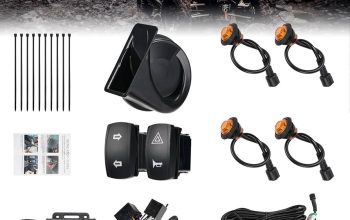The Yamaha Rmax 1000 faces issues with overheating and clutch performance. Users also report problems with the suspension system.
The Yamaha Rmax 1000 is a popular side-by-side utility vehicle known for its rugged performance and versatility. Despite its robust design, some users have experienced specific problems. Overheating can be a frequent issue, particularly during extended rides or in hot climates.
Clutch performance also tends to degrade over time, affecting the vehicle’s overall efficiency. Suspension issues can make the ride less comfortable and impact handling. Addressing these problems promptly can help maintain the vehicle’s reliability and performance. Regular maintenance and timely repairs are essential for ensuring the longevity and dependability of the Yamaha Rmax 1000.
Engine Troubles
The Yamaha Rmax 1000 is a powerful machine, but it has its engine troubles. These issues can affect performance and reliability. Below, we explore common engine problems, including starting and overheating issues.
Starting Problems
Many users report starting problems with the Yamaha Rmax 1000. This can be frustrating, especially when you are ready to ride. Here are some common causes:
- Weak or dead battery
- Faulty starter motor
- Clogged fuel filter
- Ignition switch issues
To troubleshoot, check the battery first. Ensure it’s fully charged. If the battery is fine, inspect the starter motor. Look for any signs of wear or damage. Clean or replace the fuel filter if it’s clogged. Lastly, ensure the ignition switch is working properly.
Overheating Issues
Overheating issues are another common problem with the Yamaha Rmax 1000. Overheating can cause severe engine damage. Here are some potential causes:
- Low coolant levels
- Blocked radiator
- Faulty thermostat
- Water pump failure
Regular maintenance can prevent many overheating problems. Always check the coolant levels before a ride. Make sure the radiator is clean and free of debris. Inspect the thermostat and water pump for proper function. Replace any faulty parts immediately.
| Problem | Cause | Solution |
|---|---|---|
| Starting Issues | Weak Battery | Charge or Replace Battery |
| Overheating | Low Coolant | Refill Coolant |
| Starting Issues | Clogged Fuel Filter | Clean or Replace Filter |
| Overheating | Blocked Radiator | Clean Radiator |
Transmission Concerns
The Yamaha Rmax 1000 is a powerful off-road vehicle. Yet, some users report transmission concerns. These issues can affect performance and enjoyment. Let’s explore the main problems: shifting difficulties and clutch slippage.
Shifting Difficulties
Many owners face shifting difficulties with the Yamaha Rmax 1000. This problem can occur while changing gears. It can lead to a rough riding experience. The main causes include:
- Worn-out gear components
- Improper lubrication
- Damaged shift cables
Regular maintenance can help prevent these issues. Ensure gear components are in good condition. Use the right type of lubricant. Check and replace damaged shift cables promptly.
Clutch Slippage
Clutch slippage is another common problem. It can affect the vehicle’s performance. Symptoms include a loss of power and delayed response. The primary causes of clutch slippage are:
| Cause | Description |
|---|---|
| Worn Clutch Plates | Clutch plates wear out over time, causing slippage. |
| Oil Contamination | Oil can leak onto the clutch, reducing friction. |
| Improper Adjustment | Poorly adjusted clutch can lead to slippage. |
To prevent clutch slippage, follow these steps:
- Regularly inspect clutch plates.
- Check for oil leaks.
- Ensure proper clutch adjustment.
Addressing these issues can improve your riding experience. Keep your Yamaha Rmax 1000 in top condition.
Electrical System Faults
The Yamaha Rmax 1000 is a popular ATV. Yet, it has some electrical system faults. These issues can frustrate owners and affect performance. Below, we dive into two common problems.
Battery Drain
The Rmax 1000 often faces battery drain issues. This can occur even when the ATV is not in use. Here are some potential causes:
- Poor wiring connections
- Faulty alternator
- Parasitic draw from accessories
To check for battery drain, follow these steps:
- Ensure the ATV is off.
- Disconnect the battery’s negative terminal.
- Use a multimeter to measure current draw.
If the draw is high, inspect the wiring and alternator. Fix any issues found.
Lighting Malfunctions
Lighting problems are another common issue. Lights may flicker or not work at all. The main culprits include:
- Blown fuses
- Damaged bulbs
- Faulty light switches
| Problem | Possible Cause | Solution |
|---|---|---|
| Lights Flickering | Loose wiring | Tighten connections |
| Lights Not Working | Blown fuse | Replace fuse |
| Dim Lights | Weak battery | Charge or replace battery |
Regular checks can prevent these lighting issues. Ensure all connections are secure and components are in good condition.
Suspension Problems
The Yamaha Rmax 1000 is a powerful and capable off-road vehicle. Yet, it has its share of suspension problems. Suspension issues can affect your riding experience and safety. Addressing these problems early can help you enjoy a smoother ride.
Uneven Ride
An uneven ride is one of the most common suspension problems. You might feel the vehicle tilting to one side. This can happen because the suspension system is not balanced. A few reasons for this include:
- Worn-out suspension components
- Improper alignment
- Uneven tire pressure
Regular maintenance can help keep these issues in check. Always check the suspension components and tire pressure. This can prevent an uneven ride.
Shock Absorber Wear
Shock absorbers play a crucial role in your vehicle’s suspension system. Over time, they can wear out and lose their effectiveness. This can result in a bumpy and uncomfortable ride. Signs of shock absorber wear include:
- Increased bouncing after hitting bumps
- Leaking fluid around the shock absorbers
- Visible damage or wear on the shock absorber units
If you notice any of these signs, it’s time to inspect your shock absorbers. Replacing worn-out shock absorbers can restore your vehicle’s smooth ride.
Brake System Issues
The Yamaha Rmax 1000 is a powerful and robust machine. Despite its strengths, it has some common brake system issues. These problems can affect safety and performance. Let’s look into two main concerns: brake fade and noisy brakes.
Brake Fade
Brake fade is a common problem in the Yamaha Rmax 1000. This issue occurs when the brakes lose efficiency. Often, this happens after long rides or heavy use. The brake pads and rotors get too hot. This reduces their ability to stop the vehicle.
To manage brake fade, consider the following steps:
- Use high-quality brake fluid.
- Install performance brake pads.
- Take breaks during long rides.
These steps help keep your brakes cool and efficient. This ensures your safety during rides.
Noisy Brakes
Noisy brakes can be annoying and concerning. This noise usually comes from vibrations. The vibrations happen between the brake pads and rotors. Various factors cause this issue.
Common causes of noisy brakes:
- Worn-out brake pads
- Dirty or rusty rotors
- Improper installation
To fix noisy brakes:
- Check and replace worn-out brake pads.
- Clean or replace dirty rotors.
- Ensure proper installation of brake components.
These steps will help you reduce brake noise. This will make your ride quieter and safer.
Fuel System Complications
The Yamaha Rmax 1000 is a powerful ATV. Yet, it has some issues. Fuel system complications are a common problem. These can cause poor performance and even breakdowns. Two main issues are fuel line leaks and injector blockages.
Fuel Line Leaks
Fuel line leaks are a frequent issue in the Rmax 1000. These leaks can happen because of worn-out hoses or loose fittings. Leaking fuel lines can lead to fuel wastage. This not only reduces efficiency but also poses a fire hazard.
Regular checks are essential. Inspect the fuel lines for any signs of wear or cracks. Ensure all connections are tight. Replace damaged hoses promptly. This simple step can prevent bigger issues.
Injector Blockages
Another major problem is injector blockages. Dirty or clogged injectors can affect fuel delivery. This leads to poor engine performance. It can also result in rough idling and increased fuel consumption.
Use high-quality fuel to reduce the risk of blockages. Regularly clean the fuel injectors. Consider using fuel system cleaners. These products can help keep the injectors free from deposits.
| Issue | Symptoms | Solutions |
|---|---|---|
| Fuel Line Leaks | Fuel smell, visible leaks, reduced performance | Inspect regularly, replace damaged lines |
| Injector Blockages | Rough idling, poor performance, high fuel consumption | Use quality fuel, clean injectors, use fuel cleaners |
Cooling System Challenges
The Yamaha Rmax 1000 is an impressive off-road vehicle. But, it faces some cooling system challenges. These issues can affect performance and longevity. Let’s dive into two common problems: Radiator Leaks and Coolant Contamination.
Radiator Leaks
Radiator leaks are a frequent issue in the Rmax 1000. Leaks can occur due to several reasons. The most common cause is physical damage. Off-road terrains can be harsh. Rocks and debris can hit the radiator. This causes small punctures and leaks.
Another reason is faulty seals. Over time, seals can wear out. This leads to leaks. Regular inspection can help catch these issues early.
| Cause | Solution |
|---|---|
| Physical Damage | Install a radiator guard |
| Faulty Seals | Replace worn-out seals |
Coolant Contamination
Coolant contamination is another problem. This happens when dirt or debris enters the coolant system. Contaminated coolant cannot cool the engine properly. This can lead to overheating.
Using the wrong type of coolant also causes issues. Always use the coolant recommended by Yamaha. Regularly check and flush the coolant system. This helps keep the system clean and efficient.
- Check coolant levels regularly.
- Flush the system every 6 months.
- Use the recommended coolant type.
Steering Difficulties
The Yamaha Rmax 1000 is a powerful machine, but it faces some challenges. Steering difficulties are among the most common issues users report. These problems can affect the vehicle’s performance and safety.
Stiff Steering
Stiff steering is a frequent complaint among Yamaha Rmax 1000 owners. This issue can make the vehicle hard to control. Causes of stiff steering include:
- Low power steering fluid
- Damaged steering components
- Improper lubrication
Checking and maintaining the power steering fluid can often solve this problem. Regular lubrication of steering components is also crucial. If the issue persists, professional inspection might be necessary.
Alignment Problems
Alignment problems can also cause steering difficulties. Misalignment can lead to uneven tire wear and poor handling. Common signs of alignment problems include:
- Vehicle pulling to one side
- Uneven tire wear
- Vibration in the steering wheel
Regular alignment checks can prevent these issues. If you notice these signs, get your vehicle inspected promptly. Proper alignment ensures smooth and safe rides.
Frequently Asked Questions
Is The Rmax Any Good?
Yes, the RMAX is highly praised for its durability and performance. Users appreciate its reliability and efficiency.
What Is The Recall On The Rmax 1000?
The RMAX 1000 has a recall due to potential issues with the brake system. Contact your dealer for details.
What Is The Top Speed Of The Rmax?
The top speed of the RMAX is 60 mph. This speed provides excellent performance for various outdoor activities and adventures.
What Engine Is In The Yamaha Rmax?
The Yamaha Rmax features a 999cc, parallel-twin engine. This powerful engine ensures high performance and reliability.
Conclusion
Owning a Yamaha Rmax 1000 offers excitement but comes with potential issues. Regular maintenance can prevent many problems. Stay informed about common issues to enjoy your ride. Addressing concerns promptly ensures a smoother experience. Keep your Yamaha Rmax 1000 in top shape for endless adventures.


